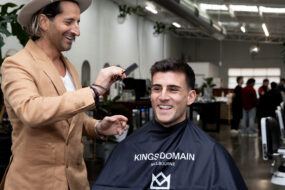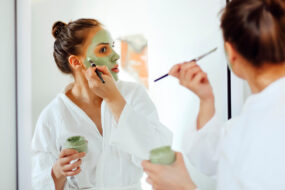Why skin picking is the ultimate skin sin (and how to stop it)
Skin picking can become one of the most destructive skincare habits. Here’s why, plus what you can do to resist temptation.
At some point, we’ve all picked at a pimple or scratched off a scab.
But picking, pulling or tearing at our skin can become a habit – we may do it out of boredom or when we are feeling stressed; and some of us may even feel compelled to do it constantly.
The problem with chronic skin picking is that it can contribute to a myriad of skin issues, including bleeding, lesions and scarring.
What is skin picking disorder?
Although skin picking is relatively common, when the habit becomes repetitive or obsessive, it is called skin picking (excoriation) disorder – an impulse control disorder that affects as many as one in 20 people.
“Picking at the skin is very common and occurs on a spectrum,” dermatologist Dr Rachael Anforth, of Woden Dermatology in Canberra, says.
“Some patients pick every now and then because they have a pimple or scale on their skin, and then there are those who pick out of habit.
“The most well-known sub-category within skin picking is probably dermatillomania, where patients have a compulsive disorder to pick.”
What happens when you pick your skin?
Gross as it sounds, the urge to squeeze a zit or pick off a scab is totally relatable – so relatable, in fact, that there is a stack of TikTok videos on skin extraction.
But beyond the relatability of skin picking, the long-term and even permanent impact of such trauma to the skin epidermis is a very real cause for concern.
According to Dr Anforth, when you pick skin you break the skin barrier, impairing its ability to function properly, which increases the risk of infection and scarring.
“The amount of damage someone can do depends on the extent of the picking,” Dr Anforth says.
If you remove the outer layer of the epidermis (the stratum corneum) through picking, the skin often heals over time with minimal scarring, Dr Anforth explains, but the deeper you pick, the more likely you are to leave a mark.
“Similarly, one of the skin’s important roles is to act as a barrier, and if you break that barrier, you are more prone to infections,” she says.
How do you stop picking your skin?
The reasons why people pick their skin varies and, consequently, there is no quick-fix solution that works for everyone – but Dr Anforth has this advice:
Know why you pick
Dr Anforth recommends making an effort to understand what type of picker you are, so you can seek more specific and targeted solutions to kick the habit.
Because everything from acne and hormonal breakouts to psoriasis and eczema can cause raised surfaces on the skin that people may want to pick at, it is equally important to identify the type of imperfections being picked at.
“If someone picks their skin simply because they feel a textural abnormality and is given advice on how to treat this in other ways, they can often be persuaded to stop picking,” Dr Anforth explains.
However, if skin picking occurs even when there is nothing to pick at, it is more likely to be a habitual behaviour.
Give pimple patches a go
It is common for occasional skin pickers to scratch or squeeze small imperfections on the face in the hope they will go away.
If spots tempt you to pick, pimple patches may help – they not only help to banish blemishes, but may also help prevent further skin picking and protect against infection.
“Pimple patches often contain ingredients to help remove the pore blockage and settle inflammation, such as salicylic acid and niacinamide,” Dr Anforth says.
“Just be sure to check the ingredients list as some contain potential irritants.”
Seek professional support
If you are a compulsive skin picker or have medically diagnosed dermatillomania, Dr Anforth recommends exploring appropriate psychological and medical treatments to treat the underlying issue.
More on bad skincare habits and skin concerns:
- 6 skin no-nos you should stop doing now
- What to do if you get sunburnt
- Sweet relief: How to deal with psoriasis
- 5 reasons your skin may be peeling
- How to treat and beat body acne for clearer skin
Written by beauty editor Charlotte Brundrett.



